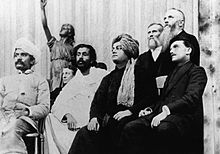Hinduism in the United States
  
   | |
| Total population | |
|---|---|
| 1,100,000 (2001) 0.4% of the UK Population | |
| Languages | |
| English · Indian Languages |
| Part of a series on |
| Hinduism |
|---|
 |

The advent of Hinduism in the United States has long been a subject for debate. It is believed that adherents to Hinduism arrived with early immigrants who may have been on the continent since the founding of the United States. The number of adherents, however, did not increase to a significant number until the passage of the Immigration and Nationality Services (INS) Act of 1965. Since then, the United States' growing Hindu population has enjoyed greater equality and attracted the attention of scholars. However, the Hindu faith is still largely unknown to the general population,[citation needed] even as more temples are built.
The ARIS study of 2001 found some 1.1 million adherents of Hinduism in the United States (0.4% of US population).
History

Swami Vivekananda addressed the World's Parliament of Religions in 1893 in Chicago. He spent two years in the United States lecturing in several cities including Chicago, Detroit, Boston and New York. In 1902 Swami Rama Tirtha visited the US lecturing on the philosophy of Vedanta. In 1920 Paramahansa Yogananda was India's delegate at the International Congress of Religious Liberals held in Boston.
Prior to 1965, Hindu immigration to the U.S. was minuscule and isolated. In those earlier days, visitors, students and some traders were primarily the only ones who bothered to set foot in the USA. The Bellingham Riots in Bellingham, Washington on September 5, 1907 epitomized the low tolerance in the USA for Indians and Hindus. Despite such events, some people including professionals stayed and worked until the Immigration and Nationality Services (INS) Act of 1965 was passed. This opened the doors to Hindu immigrants who wished to work and start families in the United States. It included Hindu preachers as well, who spread awareness of the religion among a people that had little contact with it.
In September 1965, an elderly Indian sadhu named Swami Prabhupada arrived in New York. After a short time, he acquired a troupe of followers, and founded the International Society for Krishna Consciousness. Since then many Hindu communities exist, from close-knit communities of mainstream Hindus living near one another to several farm communities owned by ISKCON.
Other influential Indians of a Hindu faith are Chinmoy and Maharishi Mahesh Yogi. Today, the most visible of the Hindu preachers appear to be those who sing the Hare Krishna Mahamantra (i.e., the Gaudiya Vaishnavas) as well as other Vaishnavas, and those of a Shaivite faith. Numerous sadhus and Gurus live in or visit the United States.
A joint session of the United States Congress was opened with a prayer in Sanskrit (with some Hindi and English added), read by Venkatachalapathi Samudrala, in September 2000, to honour the visit of Indian Prime Minister Atal Bihari Vajpayee. The historic gesture was an initiative by Ohio Congressman Sherrod Brown who requested the US Congress House Chaplain to invite the Hindu priest from the Shiva Vishnu Hindu Temple in Parma, Ohio.[1] Another Hindu prayer was read in the United States Senate on July 12 2007, by Rajan Zed, a Hindu chaplain from Nevada.[2] His prayer was interrupted by a couple and their daughter who claimed to be "Christian patriots", which prompted a criticism of candidates in the upcoming presidential election for not criticizing the remarks. [3] In October 2009, President Barack Obama lit a ceremonial Diwali lamp at the White House to symbolise victory of light over darkness.
Hindu temples in the U.S.
-
Shiva-Vishnu Temple, at Livermore, California]
The first Hindu temple is located in Northern California. Another earliest Hindu temple in the United States is the Maha Vallabha Ganapathi Devastanam owned by the Hindu Temple Society of North America in Flushing, New York City. It was consecrated on July 4, 1977. This temple recently underwent significant expansion and renovation.[4]
Other prominent temples include the Malibu Hindu Temple, built in 1981 and located in Calabasas, is owned and operated by the Hindu Temple Society of Southern California. The temple is near Malibu, California. Apart from these, Swaminarayan temples exist in several cities across the country with a sizable following.[citation needed]
Status

The Hindus of the United States seem to enjoy both de jure and de facto legal equality. Generations of Hindus, both of South Asian, as well as European ancestry, have lived and worked in the USA, raising families, buying homes, and making roots, rendering their culture and spirituality an integral part of American culture. Hindus are second most educated among all religious groups in the United States, and are the second most affluent after the Jews. 43% of American Hindus made over $100,000 per year and 48% of Hindus have post-graduate degrees[5]
Statistics
According to the United States Department of State's International Religious Freedom Report 2004, the number of Hindus in the United States is approximately 1,478,670, or 0.5% of the total population. This figure consists of immigrants from countries where Hinduism is an indigenous belief and their descendants, and Americans who adhere to Hinduism.
See also
- Californian Hindu textbook controversy
- List of Hindu temples in the United States
- Hindu American Foundation
- Hindu University of America
- Hindu denominations
- Category:Converts to Hinduism
References
- ^ For the first time, a Hindu priest will pray before US Congress, rediff.com, 14 September 2000.
- ^ "California Senate opened with Hindu prayer for first time". Asian Tribune. 2007-08-29. Retrieved 2008-07-24.
{{cite web}}: Italic or bold markup not allowed in:|publisher=(help) - ^ http://www.washingtonpost.com/wp-dyn/content/article/2007/07/27/AR2007072700206.html
- ^ Official website of the Flushing temple.
- ^ Well-educated and rich in US? Has to be a Hindu Newindpress - February 29, 2008





![Shiva-Vishnu Temple, at Livermore, California]](http://upload.wikimedia.org/wikipedia/commons/thumb/d/d2/Sa_livermore_temple.jpg/120px-Sa_livermore_temple.jpg)